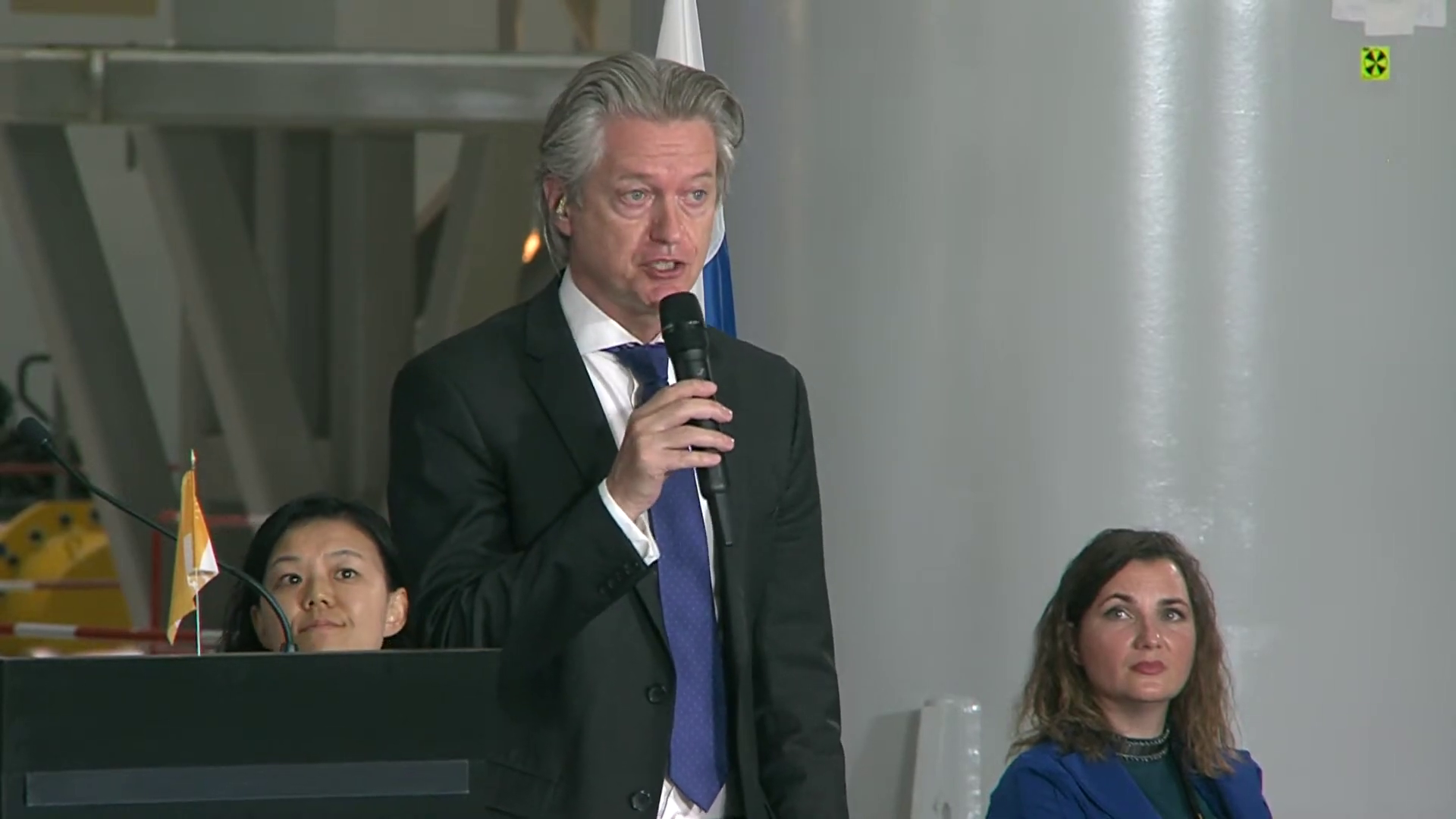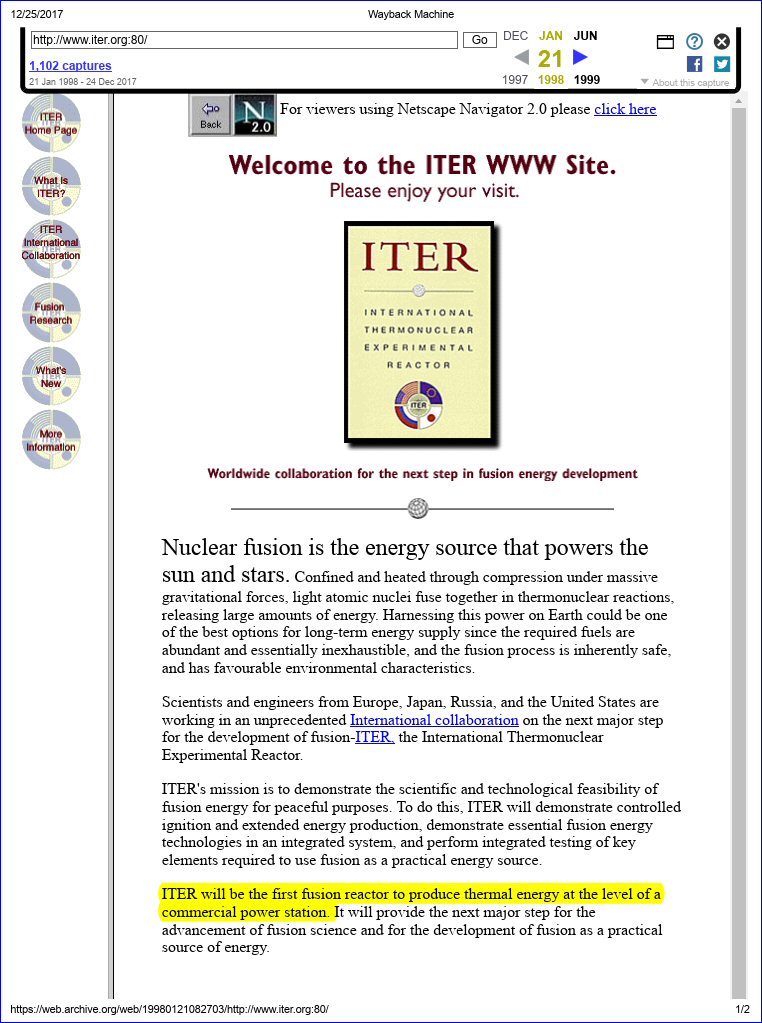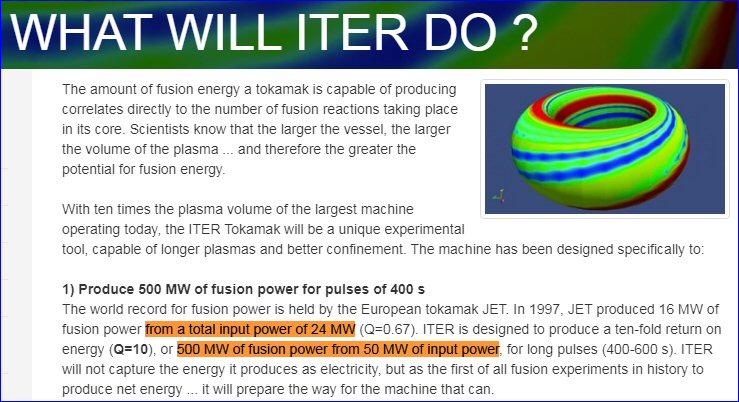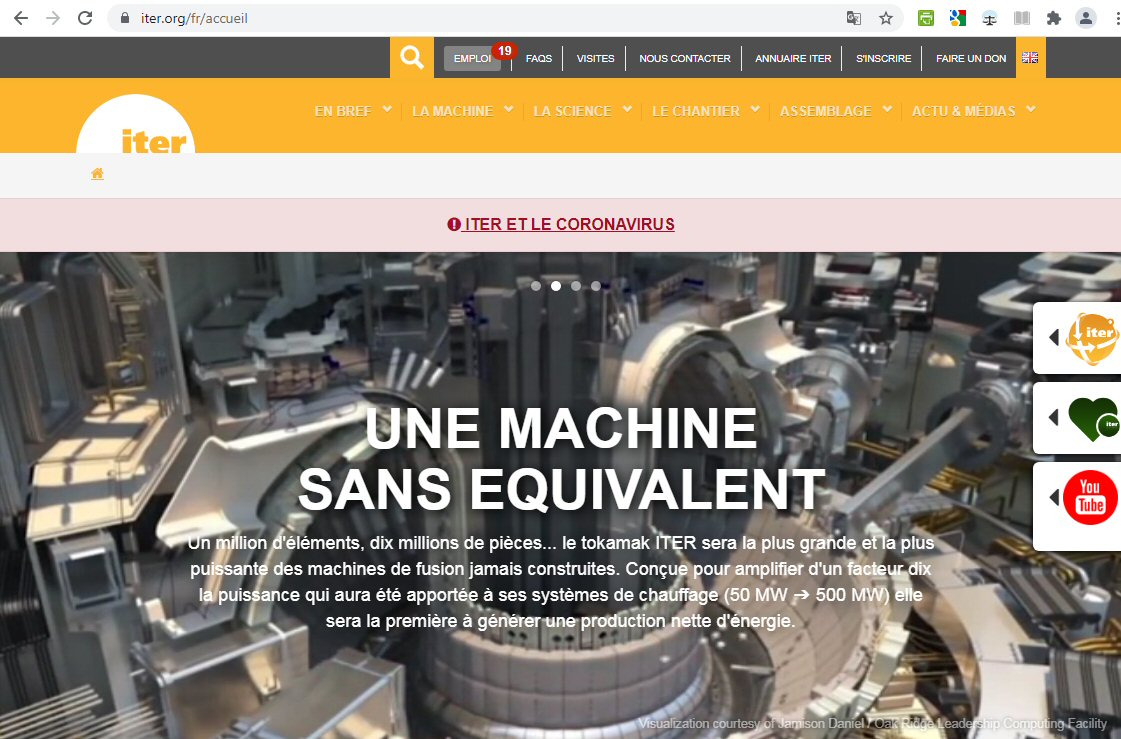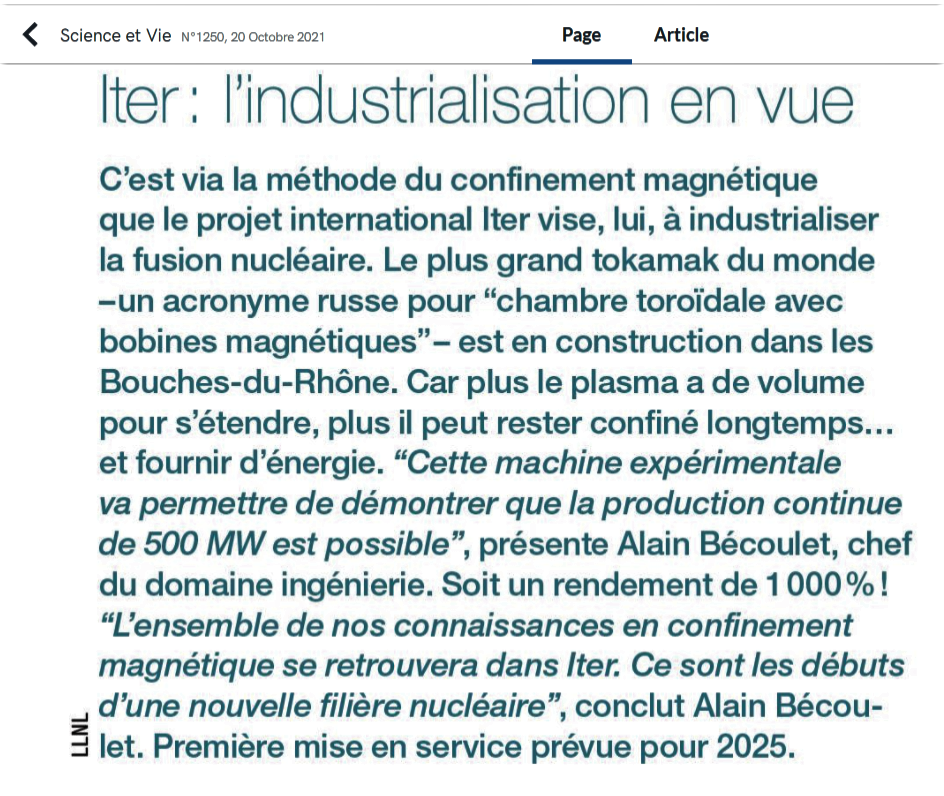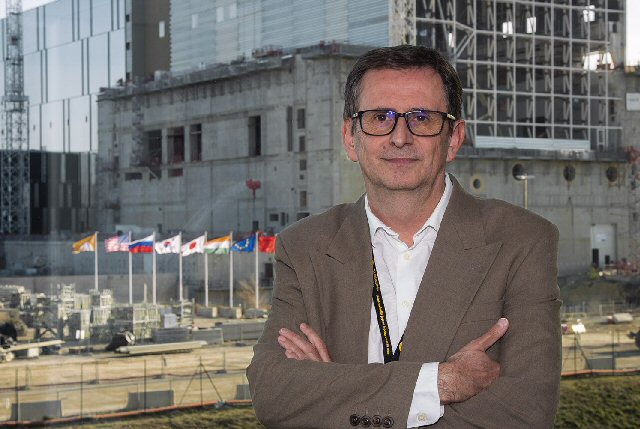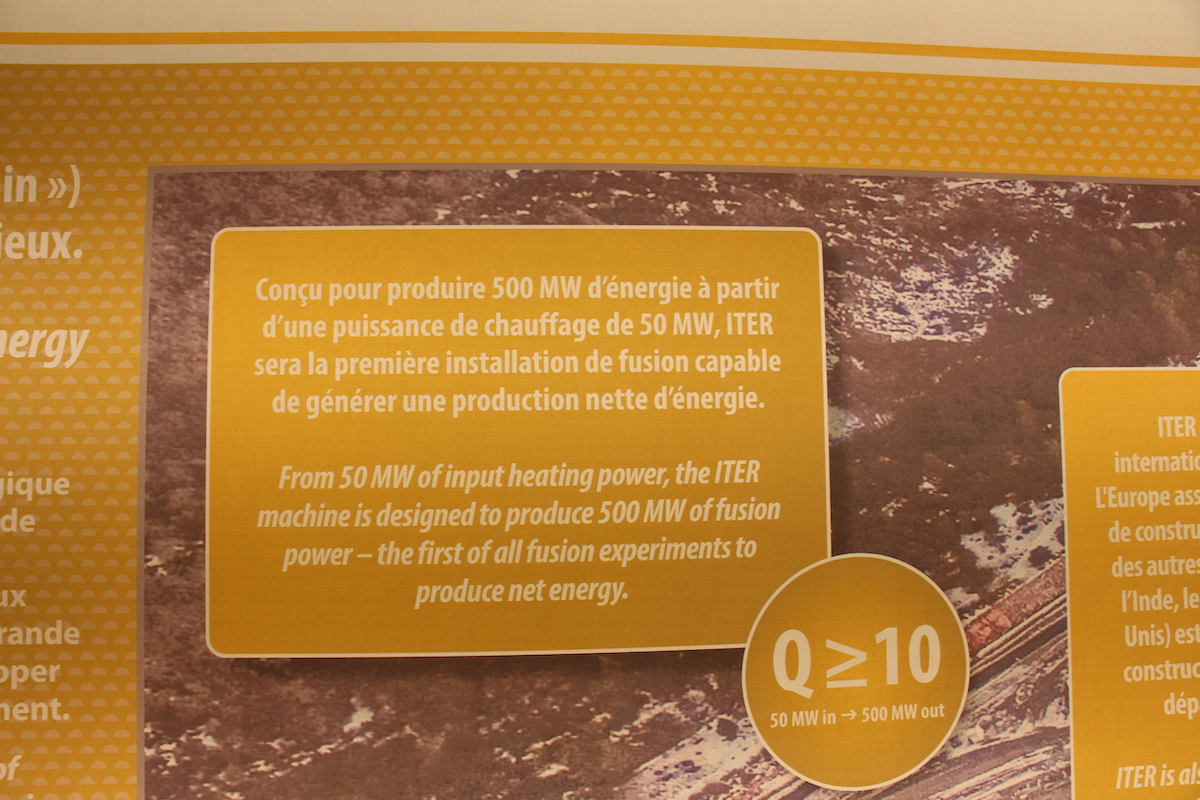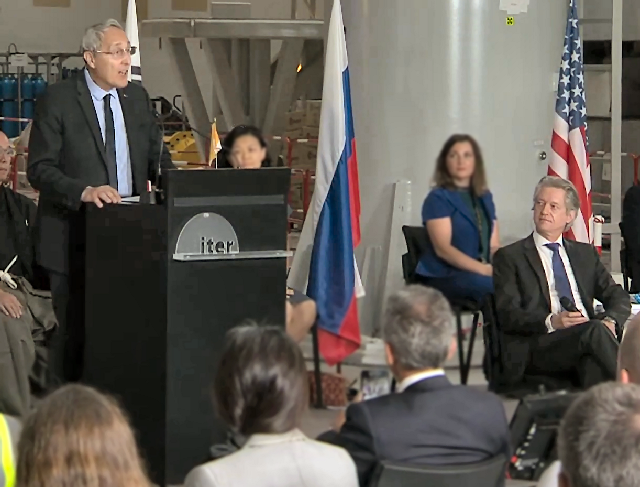
Contradicting his public relations office on the same day, Bernard Bigot, director-general of the ITER organization, claims reactor is designed for net power production, a 300% gain.
Return to ITER Power Facts Main Page
By Steven B. Krivit
Nov. 3, 2021
Cliquez ici pour la version française de cet article.
Also published today:
ITER Organization Concedes Reactor Is Not Designed for Net Power Production
Bernard Bigot Presentation to French Senate – Last 3 Minutes
The leader of the world’s largest fusion experiment testified falsely before the French Senate’s Committee on Economic Affairs last week.
On Oct. 27, 2021, during a hearing of the French Senate’s Committee on Economic Affairs, Bernard Bigot made false and exaggerated claims about the expected power output for ITER, the International Thermonuclear Experimental Reactor, under construction in the south of France.
Bigot, who is a theoretical chemist, spoke during his 40-minute presentation about climate change and fossil fuel depletion, explained the concept of nuclear fusion, then spoke about ITER.
At the end, Bigot said that, if he lives long enough, he will see the ITER reactor produce 10 times the power it will consume:
French: Et c’est en 2035, si Dieu me prête vie, que je verrai, effectivement, dix fois plus d’énergie, qu’effectivement il n’en sera consommé.
English: And it’s in 2035, if God lends me life; that I will see, effectively, ten times more energy than it will be consumed.
Nothing in the surrounding wording or context of Bigot’s statement informed the senators that he was talking only about the physics reaction. (Because ITER values are always given in terms of megawatts, the correct term is power, not energy.)
After his presentation, Bigot responded to questions from the senators. French Senator Christian Redon-Sarrazy referred to Bigot’s claim of a tenfold reactor power gain and asked for clarification:
French:Le facteur d’amplification dont vous nous avez parlé tout à l’heure, qui est de dix, ne concernerait que la réaction elle-même et n’intégrerait pas l’ensemble de l’énergie totale nécessaire au fonctionnement global du projet. Donc, même si ces consommations peuvent dépendre de la configuration des systèmes utilisés pour chaque expérience, pouvez-vous nous donner une estimation crédible et actualisée de ces différentes consommations?
English: The amplification factor that you mentioned earlier, which is ten, would only concern the reaction itself and would not include all the total energy necessary for the overall operation of the project. So, even though these consumptions may depend on the configuration of the systems used for each experiment, can you give us a credible, updated estimation of these different consumptions?
In response to this technical and precise question from the senator, Bigot changed his answer. Rather than a tenfold gain in power, he told the senators, the overall ITER reactor is expected to demonstrate a gain of three to five times the power it will consume:
French: Je produis dix fois plus de chaleur avec le plasma que je n’en injecte pour maintenir sa température, par contre, j’ai des compresseurs, j’ai effectivement, tout un système de consommation d’énergie. Donc, in fine, actuellement, le rendement sera entre trois et cinq, three et five. Aujourd’hui, si je peux me permettre, ce réacteur se veut modeste, je crois qu’il est établi du point de vue de la physique, que le facteur dix est atteignable avec ITER.
English: I produce ten times more heat with the plasma than I inject to maintain its temperature, on the other hand, I have compressors, I have indeed, a whole system of energy consumption. So, at the end of the day, the efficiency will be between three and five, three and five. Today, if I may say so, this reactor is intended to be modest, I believe that it has been established from the physics point of view that a factor of ten is achievable with ITER.
None of his answers was correct. The projected gain for the overall reactor is not ten, not five, not three, but about one.
Power Facts
New Energy Times first reported that the ITER design is equivalent to a power gain of one, that is, no power amplification, a zero-net-power reactor, four years ago.
ITER is designed to produce fusion reactions with 500 megawatts of thermal power from 50 megawatts of heating power that will be injected into the reaction chamber to heat the fuel. This is its primary measurable scientific goal. (More technically, the 500 megawatts is the kinetic energy of the produced particles that could be converted into heat.)
To accomplish this, the reactor will require 500 megawatts of electrical power to initiate the fusion reactions. The reactor will need 300 to 400 megawatts of electrical power throughout the experiment to produce the fusion reactions. If the reactor accomplishes its scientific goal, the overall reactor will not produce any net power or demonstrate a power gain. Thus, ITER is a zero-net-power reactor design. Citations and scientific references are available on the New Energy Times ITER Power Research and Analysis Web page.
Asked Again
Later in the discussion, Senator Franck Montaugé asked a similar question: “What is the true performance of an industrial facility like this?”
Bigot explained that when he talks about a power gain of 10, he is only talking about the physics gain, the plasma gain, not the overall reactor. For the overall reactor gain, Bigot said it is designed to produce three times the power the reactor will consume:
French: Le rendement dont je parle c’est le rendement entre l’énergie injectée dans le plasma pour maintenir sa température de 150 millions afin d’assurer que le plasma va être auto-entretenu avec, donc, la contribution de l’hélium produit par la réaction de fusion et la production de chaleur. C’est un rapport de quantité de chaleur, de l’énergie injectée dans le plasma et produite par le plasma. Ce n’est qu’un composant du rendement total. Le rendement total, comme je l’ai évoqué, sur ITER, il sera de l’ordre de trois. Je produirai trois fois plus d’énergie que j’en consommerai globalement.
English: The efficiency I’m talking about is the efficiency between the energy injected into the plasma to maintain its temperature of 150 million in order to ensure that the plasma will be self-sustaining with, therefore, the contribution of the helium produced by the fusion reaction and the production of heat. It is a ratio of the amount of heat, of the energy injected into the plasma and produced by the plasma. It is only one component of the total efficiency. The total efficiency, as I mentioned, on ITER, it will be about three. I will produce three times more energy than I will consume globally.
That’s just not true. The reactor is expected to consume an input of 300 to 400 megawatts of electrical power throughout the experiment to produce 500 MW of thermal power. At best, that’s a gain of 1.6. But as a demonstration of industrial capacity, the thermal output must be calculated as electrical output. A 500 MW thermal output equals a 200 MW electric output. That’s 100 MW less than the reactor will consume. Therefore, as an industrial demonstration, the ITER reactor would produce no power gain.
The reactor is not designed for demonstration of industrial fusion performance. The problem, however, is that that is exactly what proponents of fusion and the ITER project have been claiming about ITER for more than two decades.
In 1998, the ITER organization claimed on its Web site that “ITER will be the first fusion reactor to produce thermal energy at the level of a commercial power station.” In a Dec. 6, 2017, press release, the ITER organization claimed that ITER is “a project to prove that fusion power can be produced on a commercial scale.”
Therefore, considering the history, Senator Montaugé’s question was entirely appropriate. For example, the French newspaper Le Parisien, told its readers what the ITER Web site had said:
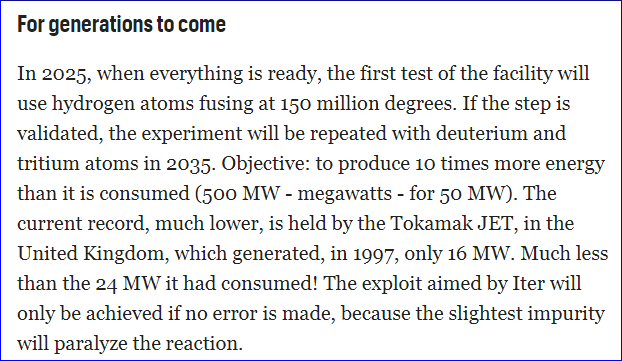
Le Parisien, translated, Feb. 5, 2019
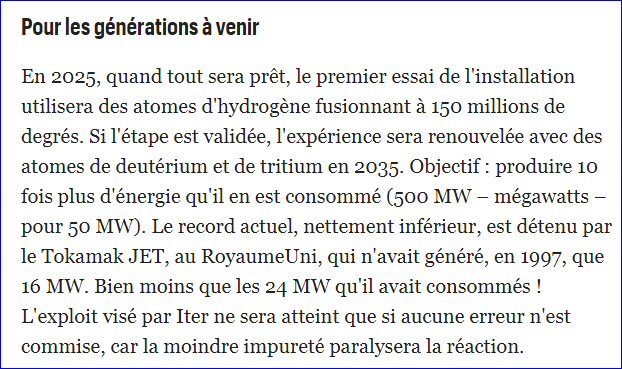
Le Parisien, Feb. 5, 2019
Bigot Knew
As a result of what I learned in 2014 about the power requirement for ITER’s predecessor, the Joint European Torus reactor, I knew that the claimed and universally cited 50-megawatt value could not represent the total required input power rate for the ITER reactor. I wrote to Bigot about the false power claims on his organization’s Web site on May 1, 2017. He did not reply. His organization did not make any corrections.
On Oct. 6, 2017, after several months of investigation, with the help of fusion scientists Daniel Jassby, Hartmut Zohm, and Steve Cowley, I published my analysis, in which I explained that the real input power-rate specification for the ITER reactor was at least 300 megawatts. My research confirmed what I had found on the Japanese government Web site: “ITER is about equivalent to a zero-net-power reactor, when the plasma is burning.”
By November 2017, Bigot and his organization began making corrections on the ITER organization’s Web site. In December, they issued a press release and omitted their previous claims that the ITER reactor was designed to consume only 50 megawatts of input power to produce a 500-megawatt thermal power output, a tenfold gain.
Instead, the press release said that the ITER reactor is designed “to prove that fusion power can be produced on a commercial scale.” With a net-power-output rate of about zero, ITER, if it proves anything, will prove the opposite.
In the following months, after I contacted international science, government, and industry organizations that also had false or misleading ITER power claims on their Web sites, they, too, made corrections.
On March 28, 2018, I reported that Bigot made misleading claims when he testified before members of the U.S. Congress. Within hours, the ITER organization corrected more of the false fusion claims on its Web site. (Bigot had done so in 2016, as well.)
I wrote to Bigot again on June 17, 2018, and explained the remaining misleading statements and claims on the ITER organization’s Web site. To my knowledge, he and his staff made no further corrections.
On July 28, 2018, Bigot’s organization issued a press release with false claims:
How much power will the ITER Tokamak provide? The plant at ITER will produce about 500 megawatts of thermal power. If operated continuously and connected to the electric grid, that would translate to about 200 megawatts of electric power, enough for about 200,000 homes.
That’s what the French newspaper Le Parisien told its readers the same day:

Le Parisien, translated, July 28, 2020

Le Parisien, July 28, 2020
After I wrote to Bigot and two members of his public relations team, they removed that press release from their Web site. I explained the details at the bottom of this news story.
The ITER organization has not issued a correction to the press release.
Transcription and translation assistance credit: M.Z. and Th.P.


